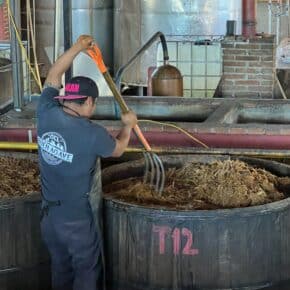I have been sitting on this article from the NY Times about the mezcal industry since it was published this past weekend because it is a bit of a mess and I needed time to digest it and discuss it with others in the mezcal world. We’ll set aside that they initially misspelled by name, we’ll also set aside the actual quote they pulled. This is a perfect example of why people hate talking to reporters: You can spend an hour talking to a reporter about the complexities of the mezcal market, who has access to capital, how the people and product are being represented, only to have one line in the whole article. Even then it can feel like your words are completely out of context.
So why is it a bit of a mess? As the article was pitched to me (and others quoted) this was supposed to be a deep dive into the business of mezcal today. Instead it ended up being a PR piece for El Silencio and their new distillery. Their PR team deserves a pat on the back for that, because getting a profile piece in the Sunday Times is a true coup. Unfortunately it’s one major missed opportunity. Instead of a story that explores the very real challenges mezcal is facing right now with spiking demand, we get someone saying generally that mezcal production is headed to one million cases a year. There’s no exploration of what that would mean for mezcal producers (or the environment!) nor who benefits from this explosive growth. Nor is there any discussion of whose voices are being amplified when it comes to talking about a product that is so laden with cultural identity, heritage, history. Mezcal is not vodka.
We have been doing our level best to explore all of these topics so if you want to read about sustainability, economic opportunity, tradition, or trends, we have you covered. We’ll continue digging into these topics with gusto because this really is a huge story that should have more attention. We’d love to hear from more people so if you have thoughts comment below or send us your perspective because, more than anything, this is a conversation that needs more voices.
As for some of the gross inaccuracies and mischaracterizations, perhaps the most glaring is the suggestion that donkeys defecate while crushing agave and their shit ends up in the mezcal. Granted it makes for great dramatic reading but is pretty far from accurate. I’ve seen plenty of mezcal made and have not seen this sort of thing, it’s a gross misrepresentation of the intense focus that mezcal makers invest in their operations. They work hard to make sure this doesn’t happen and keep their operations incredibly clean. But the bigger point is to notice who floated that idea and to understand why. El Silencio has invested millions of dollars in their state-of-the-art distillery and they justify the expense by saying that it removes horse shit from the operation?
Don’t get me wrong: The solar powered Tahona is awesome, I’d love to see more used wherever possible. It’s just unfortunate that they felt the need to sh$t on the vast majority of distillers who use horse (or mule, though rarely donkey) pulled tahonas. Who knows what the majority of producers of mezcal would do if they too had access to capital like other brands that can afford to build state-of-the-art facilities.
As for what impact this piece will ultimately have on the mezcal category, I can only hope it sparks curiosity on the part of any readers and that they begin exploring mezcal more. Based on traffic to Mezcalistas since Sunday, people definitely are hungry for more.













Thanks for putting in clear and concise words what I (and probably many others) are feeling about this.
Also: First brand to market with a Donkey Poop Pechuga wins a prize.
We already had one made that was “aged” in a pile of goat caca for 6 months before release….Mezcalero Special Bottling #4: De Cabra by Don Valente Angel Garcia in 2018….it is excellent!!
The importance of using the right preposition – on vs in 🙂 And yes, that is one delicious mezcal!
Thanks for the link to the NYTimes. I somehow missed this headline story. I feel your critique on the piece is a bit harsh. Average folks er, Times readers are not looking for deep dives into mezcal on the cover of the Times, I’m not. That’s where you, Mezacalistas and others like you come in. And which you do an excellent job of. The Times was bringing big time attention to the game.
Ok, so El Silencio was profiled or featured. Someone had to be. What they built down there, Casa Siliencio, makes them an excellent choice. If you build it they will come is no joke. And there was some mention of couple other brands. Just enough for readers to do reading up on, on their own.
The donkey defecation mention was funny, my favorite line in the whole piece, “We double-distill, but still.” I think they guy was less or more joking, and that was a good one. I chuckled out loud. But you took it to heart, literal and offense. No one thinks there’s donkey dung in their mezcal.
Overall I thought it was a good read and should pique plenty of interest for those looking for a new experience from the many other boring spirits out there. Vodka? Oof. Odorless, colorless, flavorless. Why bother? And as you say at the end, traffic to Mezcalistas is already up. Great.
Best,
Southern Texas
….And I should have mentioned that mentioning Mezcalistas website (link would have been nicer) in the NYTimes piece is far, far more important than any quotes they could have mentioned coming from you, even after an hour long interview. You mention me?
Susan, all of your criticisms of the NYT article are 100% correct; it was poorly researched, poorly written, and edited with no compunction about the Silencio spin. As you say: mezcal is not vodka. And the author is not a cultural anthropologist; she’s an “entertainment” writer. Nobody’s interests were served by this piece.
It is important to understand that the preference for an electric powered Tahona over a draft animal is a completely western / white premise. It is completely oriented towards a western market that pities the “poor animal” and monetizes this with a vegan certificate. All the hipsters feel great when they can buy such a product, even if it costs a lot more. What gets completely out of sight is the fact that the use of a draft animal is part of the local, idigenous economy, it is 100% CO2-free and the insinuation that the animals are doing badly is an absolute Western arrogance.
Thanks, Susan, for that overview. You present a list of cogent points.
I’m truly wondering if we really ought to expect more from the NYT. After all, they’ve a product to sell (the paper itself and, of course, the advertising) and likely know their target audience–who ain’t us.
Well, since I was raised on the Washington Post I always expect the Times to fall short 🙂 But, I think it is part of a larger problem happening across the board in news media, the fixation on the bottom line when everyone wants free content. So many articles are just rewrites of a press release.
While new to mezcal, which has obviously gained great interest in the U.S. and elsewhere, misrepresentations across the board on the current processing ignores the steps taken by the industry to correct any processing problems. Susan Coss is justified in pointing out the inaccuracies.